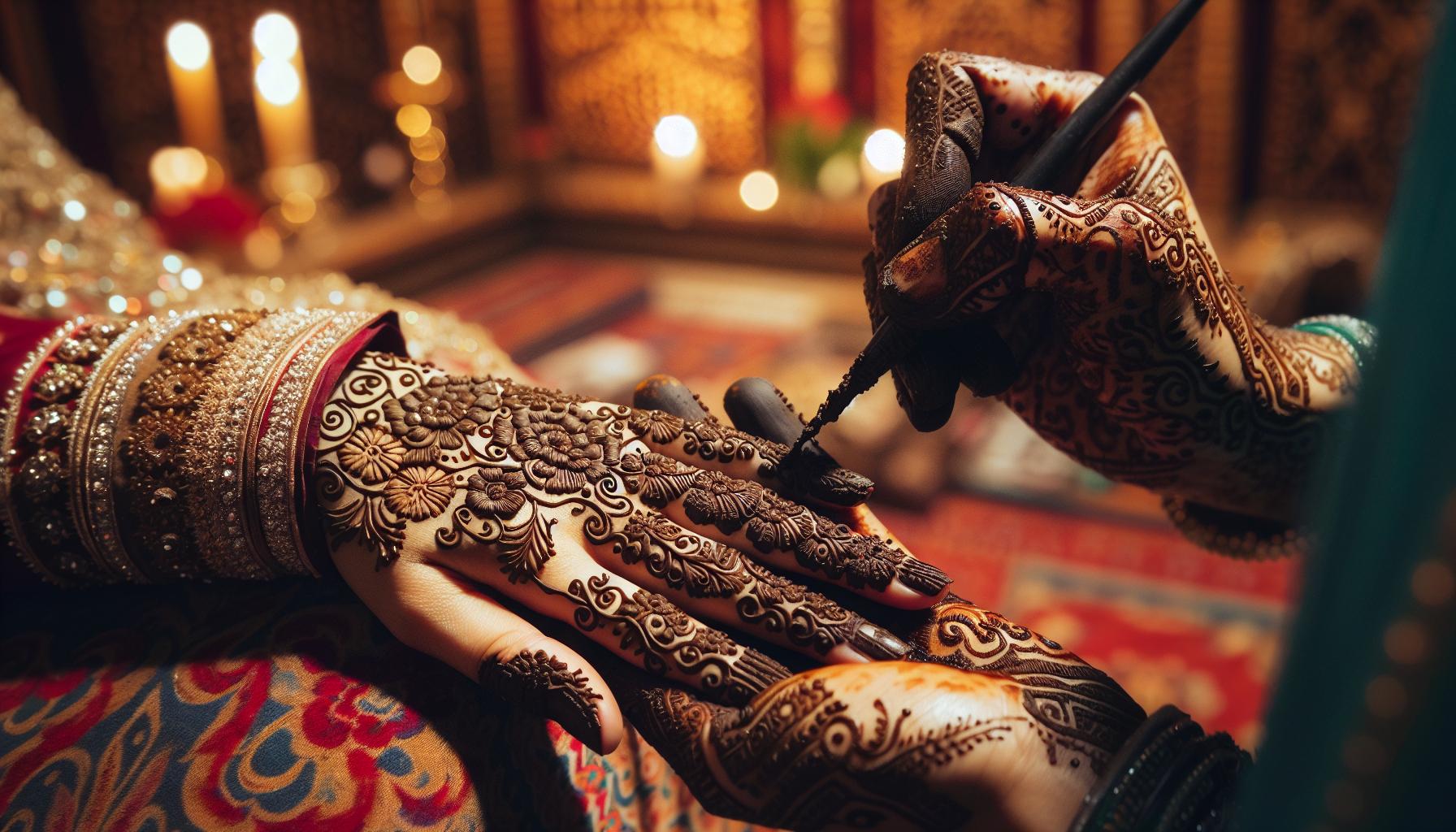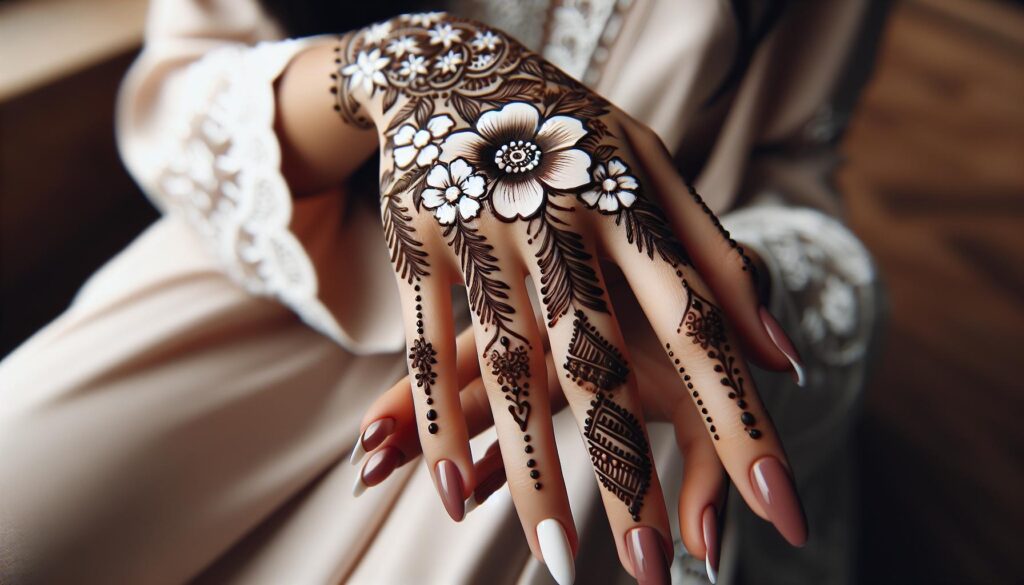As a mehndi artist, I’ve always been fascinated by the intricate patterns and designs that adorn hands and feet during special occasions. One particular style that’s caught my eye recently is the flower:dhoi_lkeheo mehndi design. This unique pattern combines traditional floral motifs with a modern twist, creating a stunning visual effect that’s sure to turn heads.
I’ve spent countless hours perfecting this technique, and I’m excited to share my insights with you. Whether you’re a seasoned mehndi enthusiast or a curious beginner, this article will guide you through the ins and outs of the flower:dhoi_lkeheo design. From its origins to step-by-step instructions, I’ll cover everything you need to know to create this beautiful art form.
Key Takeaways
- Flower:dhoi_lkeheo mehndi design combines traditional floral motifs with modern elements, featuring symmetry, layering, and intricate details
- The design originated in the Indian subcontinent and holds cultural significance in Hindu and Muslim traditions, symbolizing prosperity and celebration
- Key characteristics include a central flower motif, elongated curved petals, and geometric accents, creating a visually striking and balanced composition
- Application techniques involve precise tools, proper henna paste preparation, and mastery of the dhoi_lkeheo technique for creating lifelike floral patterns
- Proper aftercare, including drying, sealing, and moisturizing, is crucial for maintaining the vibrancy and longevity of flower:dhoi_lkeheo mehndi designs
Flower:dhoi_lkeheo= Mehndi Design
The flower:dhoi_lkeheo= mehndi design is a unique blend of traditional floral patterns and contemporary elements. I’ve found that this style combines intricate petal shapes with geometric accents, creating a visually striking and balanced composition. The design typically features a central flower motif surrounded by smaller floral elements, interconnected with delicate lines and dots.
Key characteristics of the flower:dhoi_lkeheo= design include:
- Symmetry: Balanced arrangement of elements on both sides
- Layering: Overlapping petals and leaves for depth
- Negative space: Strategic use of empty areas to enhance overall design
- Fine details: Intricate patterns within larger motifs
- Flowing lines: Curved elements connecting different parts of the design
The name “dhoi_lkeheo=” refers to a specific technique used in creating the central flower. This method involves drawing elongated petals with a slight curve, giving the impression of a blooming flower. The design’s popularity stems from its versatility, as it’s suitable for various occasions and can be adapted to different body parts.
To master the flower:dhoi_lkeheo= mehndi design, I’ve identified these essential skills:
- Precision in line work
- Understanding of floral anatomy
- Ability to create balanced compositions
- Knowledge of traditional mehndi motifs
- Creativity in incorporating modern elements
By combining these skills, artists can create stunning flower:dhoi_lkeheo= designs that captivate viewers and showcase the beauty of this unique mehndi style.
Origins and Cultural Significance

The flower:dhoi_lkeheo= mehndi design has deep roots in traditional henna art and cultural practices. Its origins can be traced back to ancient civilizations, where it evolved into a significant form of body art with rich symbolic meanings.
Traditional Roots of Dhoi_lkeheo= Mehndi
The dhoi_lkeheo= mehndi technique originated in the Indian subcontinent, specifically in the regions of Gujarat and Rajasthan. This intricate floral design evolved from traditional paisley and mandala patterns, incorporating elements of nature and geometric shapes. Artisans in these regions developed the unique petal-drawing technique to create more realistic and visually striking flower motifs. The design’s popularity spread throughout South Asia, influencing mehndi styles in neighboring countries like Pakistan and Bangladesh.
Symbolic Meaning in Various Cultures
In Hindu culture, the flower:dhoi_lkeheo= mehndi design symbolizes fertility, prosperity, and spiritual awakening. The intricate petals represent the unfolding of life and the blossoming of one’s potential. In Muslim traditions, this design is often associated with celebration and joy, particularly during weddings and religious festivals. The symmetry and balance in the pattern reflect harmony and unity. In some Middle Eastern cultures, the flower:dhoi_lkeheo= design is believed to ward off evil spirits and bring good fortune to the wearer. The interconnected lines and dots in the design symbolize the interconnectedness of all living things, reinforcing the importance of community and relationships in many cultures where mehndi art is practiced.
Characteristics of Flower:dhoi_lkeheo= Mehndi Patterns

Flower:dhoi_lkeheo= mehndi patterns are distinguished by their intricate floral designs and unique geometric accents. I’ve identified several key characteristics that make this style stand out in the world of mehndi art.
Key Design Elements
The flower:dhoi_lkeheo= mehndi patterns incorporate:
- Symmetry: Balanced arrangements of floral elements create visually appealing designs
- Layering: Overlapping petals and leaves add depth and dimension
- Negative space: Strategic use of empty areas enhances the overall composition
- Fine details: Intricate linework and delicate dots embellish the main motifs
- Flowing lines: Curved stems and tendrils connect different elements seamlessly
- Geometric accents: Angular shapes contrast with organic floral forms
- Central focal point: A prominent flower serves as the design’s centerpiece
These elements combine to create a harmonious blend of traditional and contemporary mehndi styles.
Popular Floral Motifs
Flower:dhoi_lkeheo= mehndi patterns feature a variety of floral motifs, including:
- Lotus: Symbolizes purity and spiritual awakening
- Rose: Represents love and beauty
- Marigold: Signifies auspiciousness and celebration
- Jasmine: Denotes elegance and fragrance
- Sunflower: Embodies happiness and vitality
- Chrysanthemum: Symbolizes longevity and nobility
- Hibiscus: Represents femininity and passion
Each motif is meticulously crafted using the dhoi_lkeheo technique, which involves creating elongated, curved petals to achieve a lifelike, blooming appearance. The combination of these diverse floral elements results in captivating designs that appeal to a wide range of preferences and cultural backgrounds.
Application Techniques and Tools

I’ve perfected my approach to creating stunning flower:dhoi_lkeheo mehndi designs through years of practice. The key lies in proper preparation and skilled application techniques.
Preparing the Henna Paste
To create the perfect henna paste for flower:dhoi_lkeheo designs, I mix high-quality henna powder with lemon juice, sugar, and essential oils. The consistency should be smooth and thick, similar to toothpaste. I strain the mixture through a fine mesh to remove any clumps, ensuring a smooth flow during application. For optimal results, I let the paste sit for 4-6 hours before use, allowing the dye to release.
Mastering the Art of Application
Applying flower:dhoi_lkeheo mehndi designs requires precision and control. I use various tools, including:
- Plastic cones: For fine lines and intricate details
- Jacquard bottles: For filling larger areas
- Thin brushes: For touch-ups and corrections
I start by outlining the central flower using smooth, curved strokes. Then, I add layers of petals, gradually working outward. For the dhoi_lkeheo technique, I create elongated, curved petals with varying thickness to achieve a three-dimensional effect. I incorporate fine lines, dots, and geometric accents to connect floral elements and add depth to the design. Throughout the process, I maintain a steady hand and consistent pressure to ensure even application.
Modern Interpretations and Trends
The flower:dhoi_lkeheo mehndi design has evolved significantly in recent years, adapting to contemporary aesthetics while maintaining its traditional roots. I’ve observed how this intricate art form has embraced modern influences, resulting in stunning new interpretations that appeal to a global audience.
Fusion with Contemporary Designs
The fusion of flower:dhoi_lkeheo with contemporary designs has given rise to innovative patterns that blend traditional and modern elements. Artists now incorporate geometric shapes, minimalist lines, and abstract forms alongside the classic floral motifs. I’ve seen stunning examples where the central dhoi_lkeheo flower is surrounded by sleek, angular patterns or paired with negative space designs for a more avant-garde look. This fusion approach allows for greater creativity and personalization, appealing to those seeking a unique twist on traditional mehndi art.
Popularity in Western Fashion
Flower:dhoi_lkeheo mehndi has gained significant traction in Western fashion circles, transcending its cultural origins. Celebrities and influencers have embraced this art form, showcasing elaborate designs at red carpet events and music festivals. Fashion designers have incorporated flower:dhoi_lkeheo-inspired patterns into their collections, featuring the intricate motifs on clothing, accessories, and even temporary tattoos. This growing popularity has led to a surge in mehndi-inspired nail art, jewelry, and home decor items, demonstrating the versatility and appeal of this beautiful design across various mediums.
Occasions and Celebrations
Flower:dhoi_lkeheo mehndi designs grace a wide array of occasions and celebrations, adding beauty and cultural significance to various events. I’ve seen these intricate patterns enhance the beauty of participants and create lasting memories across different cultural contexts.
Weddings and Festive Events
Weddings are prime occasions for showcasing flower:dhoi_lkeheo mehndi designs. Brides often adorn their hands and feet with elaborate patterns, symbolizing love, fertility, and new beginnings. The intricate floral motifs complement bridal attire and jewelry, creating a cohesive look. During festivals like Diwali, Eid, and Karva Chauth, women apply these designs to celebrate and honor traditions. The versatility of flower:dhoi_lkeheo patterns allows for customization to suit specific cultural preferences and event themes.
Everyday Wear and Self-Expression
Flower:dhoi_lkeheo mehndi designs aren’t limited to special occasions. Many enthusiasts incorporate simplified versions into their everyday look. These designs serve as a form of self-expression, allowing individuals to showcase their creativity and cultural appreciation. I’ve noticed a trend of people opting for small, delicate flower:dhoi_lkeheo inspired tattoos or temporary mehndi designs on wrists, ankles, or behind the ear. This everyday application of the art form has gained popularity among younger generations, blending traditional aesthetics with contemporary fashion sensibilities.
Maintenance and Aftercare
Proper maintenance and aftercare are crucial for preserving the beauty and longevity of flower:dhoi_lkeheo mehndi designs. I’ll share my expert tips to ensure your intricate artwork stays vibrant and intact for as long as possible.
Drying and Setting
After applying the mehndi paste, it’s essential to let it dry completely. I recommend:
- Avoiding contact with water for at least 6-8 hours
- Using a mixture of lemon juice and sugar to seal the design
- Wrapping the decorated area in plastic wrap to retain heat and moisture
Removing the Paste
Once the paste has dried:
- Gently scrape off the dried henna using a spoon or butter knife
- Avoid washing the area immediately after removal
- Apply a thin layer of oil (coconut or olive) to intensify the color
Color Development
To achieve the deepest, richest color:
- Keep the area warm and moist for 24-48 hours
- Apply a balm containing eucalyptus oil to enhance staining
- Avoid excessive sweating or exposure to chlorine
Long-term Care
To extend the life of your flower:dhoi_lkeheo mehndi design:
- Moisturize the area daily with natural oils
- Minimize exposure to harsh soaps and chemicals
- Avoid exfoliating the decorated skin
Touch-ups and Reapplication
For events lasting several days:
- Use natural henna-based touch-up cones for quick fixes
- Reapply a thin layer of henna paste to intensify fading areas
- Consider professional touch-ups for intricate designs
By following these maintenance and aftercare tips, your flower:dhoi_lkeheo mehndi design will remain stunning and vibrant, allowing you to fully enjoy this beautiful art form for an extended period.
Stunning Mehndi Artwork
The flower:dhoi_lkeheo mehndi design is a captivating blend of tradition and innovation. I’ve shared my passion and expertise to help you master this intricate art form. From its rich cultural heritage to modern interpretations, this design continues to evolve and inspire. By honing your skills and following the techniques I’ve outlined, you’ll create stunning mehndi artwork that celebrates beauty and cultural appreciation. Remember, practice makes perfect. So grab your henna cone and let your creativity bloom with the flower:dhoi_lkeheo mehndi design.
